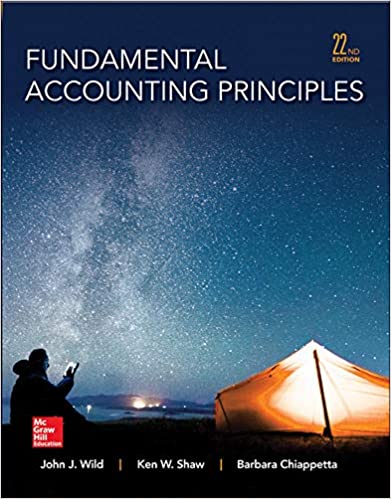
Fundamental Accounting Principles 22th Edition by John Wild ,Ken Shaw,Barbara Chiappetta
Edition 22ISBN: 978-0077862275
Fundamental Accounting Principles 22th Edition by John Wild ,Ken Shaw,Barbara Chiappetta
Edition 22ISBN: 978-0077862275 Exercise 15
Match the definitions 1 through 9 with the term or phrase a through i.
A. Budget
B. Merchandise purchases budget
C. Cash budget
D. Safety stock
E. Budgeted income statement
F. General and administrative expense budget
G. Sales budget
H. Master budget
I. Budgeted balance sheet
_________ 1. A comprehensive business plan that includes specific plans for expected sales, the units of product to be produced, the merchandise or materials to be purchased, the expenses to be incurred, the long-term assets to be purchased, and the amounts of cash to be borrowed or loans to be repaid, as well as a budgeted income statement and balance sheet.
_________ 2. A quantity of inventory or materials over the minimum to reduce the risk of running short.
_________ 3. A plan showing the units of goods to be sold and the sales to be derived; the usual starting point in the budgeting process.
_________ 4. An accounting report that presents predicted amounts of the company's revenues and expenses for the budgeting period.
_________ 5. An accounting report that presents predicted amounts of the company's assets, liabilities, and equity balances at the end of the budget period.
_________ 6. A plan that shows the units or costs of merchandise to be purchased by a merchandising company during the budget period.
_________ 7. A formal statement of a company's future plans, usually expressed in monetary terms.
_________ 8. A plan that shows predicted operating expenses not included in the selling expenses budget.
_________ 9. A plan that shows the expected cash inflows and cash outflows during the budget period, including receipts from any loans needed to maintain a minimum cash balance and repayments of such loans.
A. Budget
B. Merchandise purchases budget
C. Cash budget
D. Safety stock
E. Budgeted income statement
F. General and administrative expense budget
G. Sales budget
H. Master budget
I. Budgeted balance sheet
_________ 1. A comprehensive business plan that includes specific plans for expected sales, the units of product to be produced, the merchandise or materials to be purchased, the expenses to be incurred, the long-term assets to be purchased, and the amounts of cash to be borrowed or loans to be repaid, as well as a budgeted income statement and balance sheet.
_________ 2. A quantity of inventory or materials over the minimum to reduce the risk of running short.
_________ 3. A plan showing the units of goods to be sold and the sales to be derived; the usual starting point in the budgeting process.
_________ 4. An accounting report that presents predicted amounts of the company's revenues and expenses for the budgeting period.
_________ 5. An accounting report that presents predicted amounts of the company's assets, liabilities, and equity balances at the end of the budget period.
_________ 6. A plan that shows the units or costs of merchandise to be purchased by a merchandising company during the budget period.
_________ 7. A formal statement of a company's future plans, usually expressed in monetary terms.
_________ 8. A plan that shows predicted operating expenses not included in the selling expenses budget.
_________ 9. A plan that shows the expected cash inflows and cash outflows during the budget period, including receipts from any loans needed to maintain a minimum cash balance and repayments of such loans.
Explanation
Master budget is a comprehensive busines...
Fundamental Accounting Principles 22th Edition by John Wild ,Ken Shaw,Barbara Chiappetta
Why don’t you like this exercise?
Other Minimum 8 character and maximum 255 character
Character 255


